Creativity of Heritage: Debating the Castle and the Eye of York
Neil Redfern, Principal Inspector for Historic England in Yorkshire
Saturday 20 July 2019
Heritage isn’t fixed, it isn’t just old buildings, it isn’t all about the past – it’s a way of debating what matters to us today and how we value it.
We have created a virtual tour of Neil’s walk to share some of the histories and stories discussed.

The founding of York
Following the last Ice Age, the high land around York was the only dry land for miles around. This is the reason why the Romans founded Eboracum (later York), where they did.
Political Significance
As we flash forward over a millennium , we reach a period in history where the Eye of York was at the heart of one of the fiercest and most restless political campaigns in history. In the 19th century, elections in Yorkshire would take place at the Eye.
In 1807, William Wilberforce stood on an anti-slavery platform, against two opponents, including a slave owner from the Lascelles’ family. For a month, every day at 9am, the trio would debate, with slavery the common theme. Eventually, Wilberforce prevailed, and the rest is history.
Victorian Prison

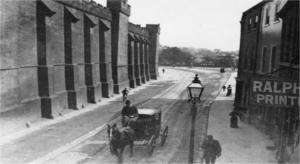
At the front of Clifford’s Tower, the group were asked to imagine the height of the walls of the Victorian prison. Next time you are walking along Tower Street, stand on the pavement and look up at the Crown Court. The walls would reach up to at least the same height of the roof of the Court building.
Castle Moat
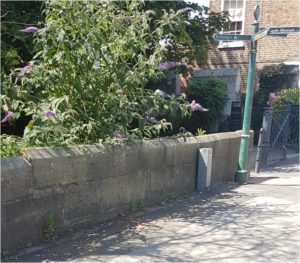 Also along Tower Street, make a point to look at the wall separating Tower Gardens and the street – close to the gateway the wall is cracked and tilts at an angle. This subsidence in the wall is believed to be due to the soft ground underneath, which is where the moat of the ancient castle is understood to have run .
Also along Tower Street, make a point to look at the wall separating Tower Gardens and the street – close to the gateway the wall is cracked and tilts at an angle. This subsidence in the wall is believed to be due to the soft ground underneath, which is where the moat of the ancient castle is understood to have run .
Prison Gates
As we continued our walk, we study a picture of the old prison gates, where anyone entering the prison or courts would go through. Clearly visible on the grass, although, tragically, not to a camera, are two slightly raised areas either side of a slight central depression. This, we believe, is the exact site of the old prison gate, with the central depression marking the route through .
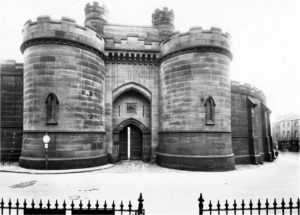
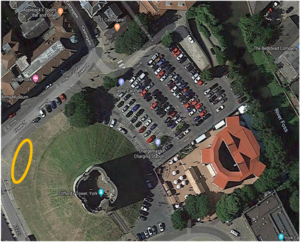
Castlegate
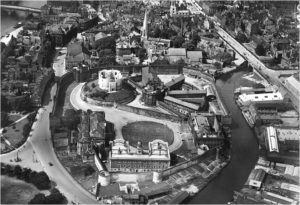
At the end of Castlegate stands a simple two story building that was once the office of architect George Townsend Andrews, the designer of the County Jail built around Clifford’s Tower. His panoptical design meant that all prisoners could potentially be observed by a single guard in a tower at the centre of the prison, without knowing who is under scrutiny.
River Foss
The only remaining part of the Prison walls is visible on the banks of the River Foss. When the rest of the walls were demolished around 1935, the stone was sold off and some was re-used in new buildings.
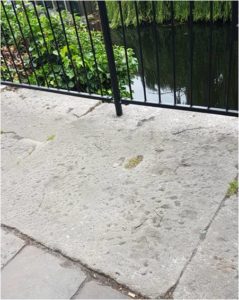
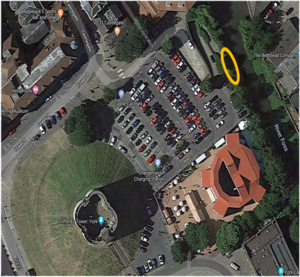
Executions
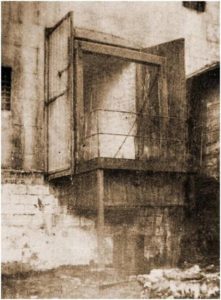 Neil shared a symphony of historical knowledge, from the weird and wonderful ‘crimes’, such as that heinous crime of…. Witchcraft that resulted in an execution.
Neil shared a symphony of historical knowledge, from the weird and wonderful ‘crimes’, such as that heinous crime of…. Witchcraft that resulted in an execution.
The group was shown images of the Long Walk. This long and drab corridor was where condemned men would make their final journey from their prison to the gallows at the side of the Museum (then the Female Prison ).
It is also on these grounds that some of these people were buried. Recent studies have revealed that some of these bodies are missing limbs, suggesting that the bodies were used in medical experiments after death.
Eye of York
Can you spot the difference between these images, in comparison to their modern day facades?


Found it? It is… the moving urns. They started on the roof of the court, only to be moved to the shoulders of the perron, only to then move back onto the roof. On the Female prison, what is now part of the museum, the urns have disappeared completely. Why were they moved around on the Court? Where have the urns from the Castle Museum gone? Listen to Historic England’s Neil Redfern below.
Questions
Is there potential for an archaeological dig at the site? Unfortunately, the Victorian jail was designed to avoid anyone tunnelling in, and thus the foundations would have destroyed any potential finds. In the late 1930’s work began on the former jail site on a new Council office. Whilst this development was abandoned due to the war, the foundations and basements are believed to still be present.
Why was Clifford’s Tower saved when the prison was built? Although the reason is uncertain , it was suggested that it was retained by the Governor of the prison, who used Clifford’s Tower as a symbol of the power that was conferred upon him by the Crown.
Close
And so, that brings our tour to its conclusion. Although only a snippet of the long and varied history of the area, it shows just how significant this area is to York’s history.
In keeping with the tussle over meaning and power that have defined this part of York – we want to know what these histories and stories mean to you (their significance) and what might they mean for how we see the future of the area?
If you’ve enjoyed this blog, why not come to one of our many events over the summer to hear ideas and share your thoughts on the project. Book on at http://www.mycastlegateway.org/events or offer your thoughts to us on Twitter, Facebook, or Instagram.
Follow @MyCastlGateway for more events and conversations.
If you’ve found this interesting so far, follow the link below to learn more about the history of the Eye of York: